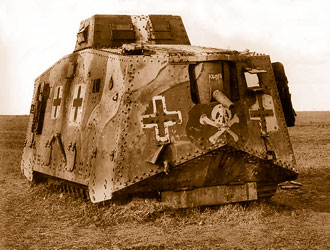German Tank Battalions (Panzer-Abteilungen)
L'arrivée sur les champs de bataille des premiers chars britanniques, le 14 septembre 1916, jeta un grand effroi dans les rangs allemands. Ceux-ci lancèrent leur programme de blindés peu après. Cependant les premiers A7V ne furent livrés à l'armée impériale allemande le 1er octobre 1917 soit environ 1 an plus tard ! Deux unités furent immédiatement constituées; les Abteilungen 1 et 2. Chacune comprenait 6 officiers, 170 sous-officiers et soldats et 5 chars seulement. La production ne fut jamais à la hauteur en comparaison de celles des Alliés. En effet un total insignifiant de 20 A7V fut produit alors que les Alliés produiront des chars par centaines. Les autres modèles de chars allemands ne dépassèrent jamais le stade de prototype. Trop rares, les A7V étaient en plus des chars mal conçus, peu fiables et peu stables. En décembre 1917, une troisième unité fut constituée, le Panzer Abteilung 3.
Arrival on the battle fields of the first British tanks, on September 14, 1916, threw a great fear in the German rows. Those launched their program of tanks shortly after. However the first A7V were not delivered to German Imperial army on October 1, 1917 is approximately 1 year later! Two units were immediately made up; Abteilungen 1 and 2. Each one included 6 officers, 170 warrant officers and soldiers and 5 tanks only. The production was never at the height compared to those of the Allies. Indeed a poor total of 20 A7V was produced whereas the Allies produce tanks per hundreds. The other models of German tanks never exceeded the stage of prototype. Too much rare, A7V was in addition tanks badly designed, not very reliable and not very stable. In December 1917, a third unit was constitued, Panzer Abteilung 3.

Le baptême du feu des A7V eut lieu le 21 mars 1918 durant la bataille de St Quentin. Le 24 avril, les 3 Abteilungen furent engagés ensemble lors de la bataille de Villers-Bretonneux. Treize chars sur 15 furent engagés avec un effet moral considérable sur les Alliés mais un fut perdu (en se renversant) et examiné par les Français.
The baptism of fire of A7V took place on March 21, 1918 during the battle of St Quentin. On April 24, 3 Abteilungen were committed whole at the time of the battle of Villers-Bretonneux. Thirteen tanks out of 15 were engaged with a considerable moral effect on the Allies but one was lost (while reversing itself) and was examined by the French.
 |
 |
A7V
- Allegmeine-Kriegs-Department 7, Abteilung Verkehrswesen |
|
src:
? |
src:
site Landships |
Le 15 juillet 1918, vingt A7V furent lancés à l'attaque des lignes françaises mais furent sérieusement ébranlés par la riposte de l'artillerie. En tout 7 Panzer Abteilungen furent constitués par les allemands (3 étaient constitués de chars A7V, les 4 autres (Beutepanzer Abteilungen) furent équipés de matériel ennemi capturé comme les Mark IV et V britannique, le Whippet britannique ou le Renault FT français). Quelques jours avant l'armistice, le 8 novembre, les 11 derniers A7V allemands se heurtèrent aux Mark V du 12e bataillon britannique, ce fut la première bataille de chars de l'histoire.
On July 15, 1918, twenty A7V were launched to the assault of French lines but were seriously shaken by the response of artillery. In all 7 German Panzer Abteilungen were consisted (3 consisted of tanks A7V, the 4 others (Beutepanzer Abteilungen) were equipped with enemy material captured like the British Mark IV and V , British Whippet or the French Renault FT). A few days before armistice, on November 8, the last 11 A7V German ran up against the Mark V of the 12th British battalion, it was the first battle of tanks of history.
-
L'Uniforme et les Armes des Soldats de la Guerre 1914-1918 , Tome 1, Ed. Casterman